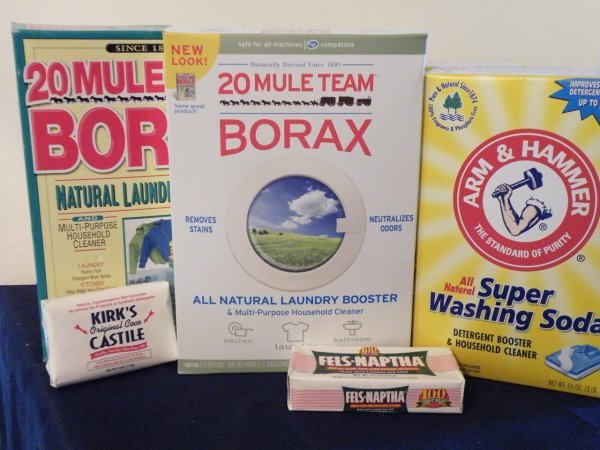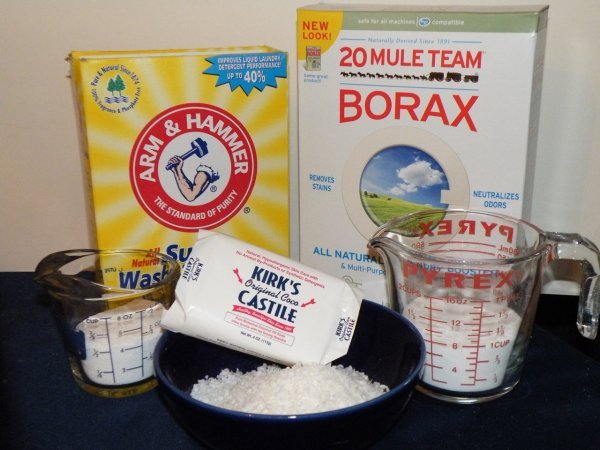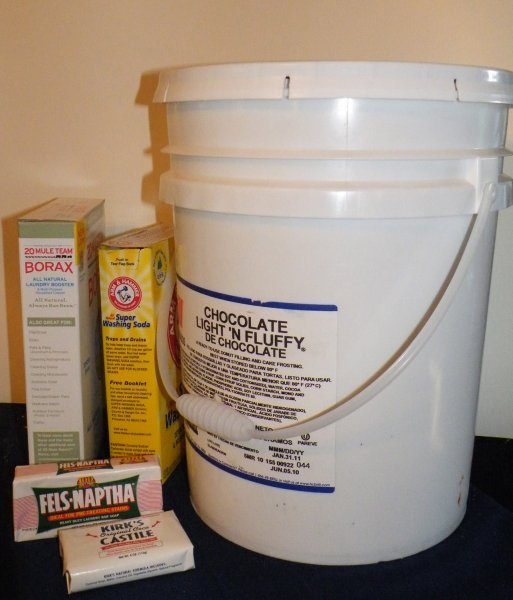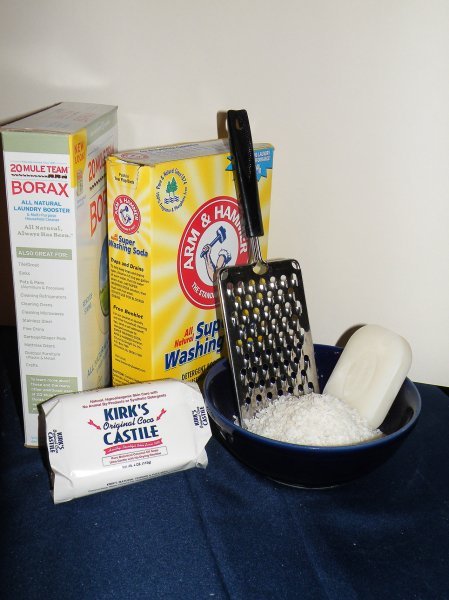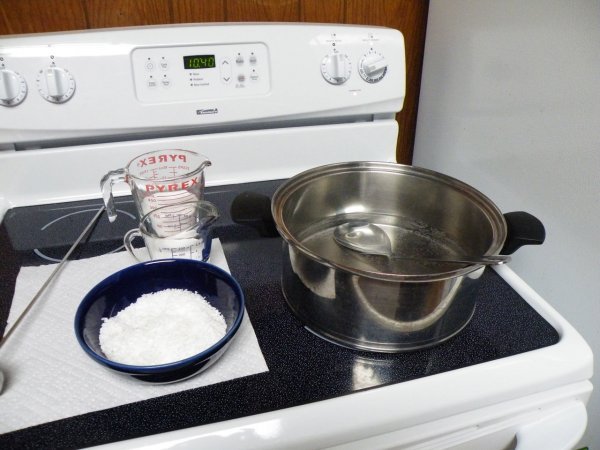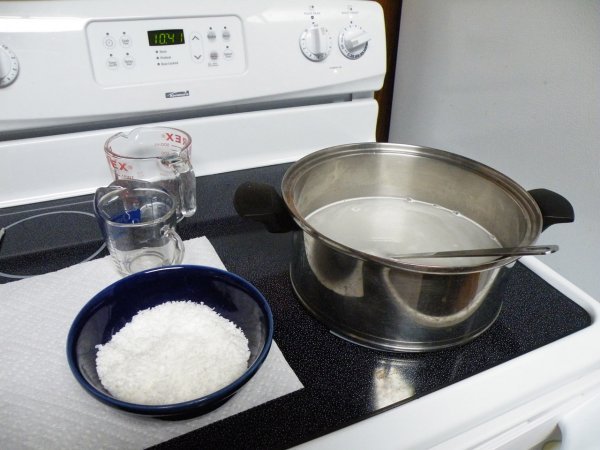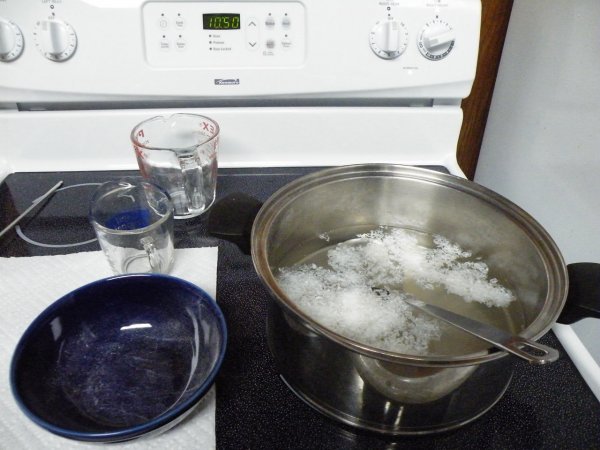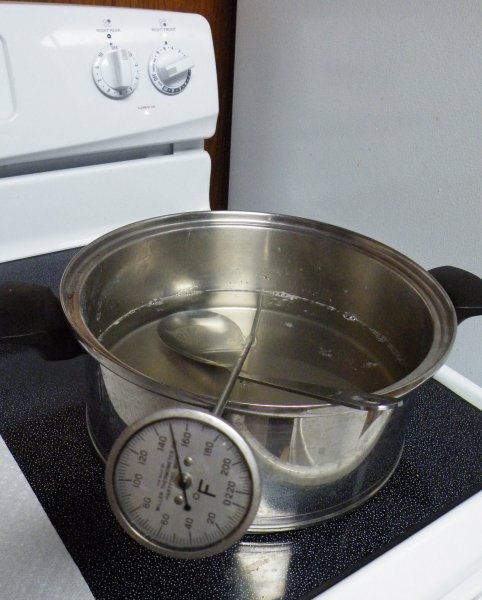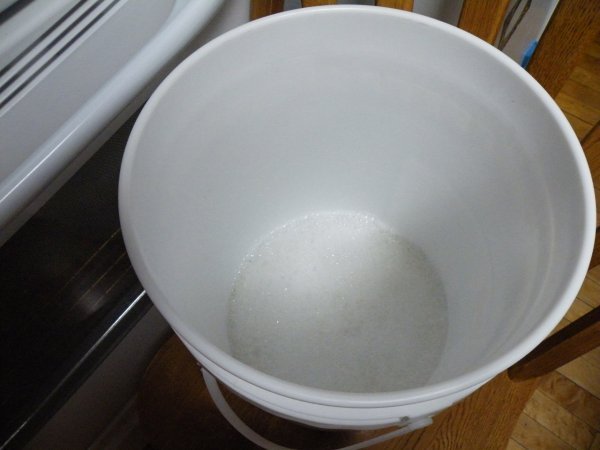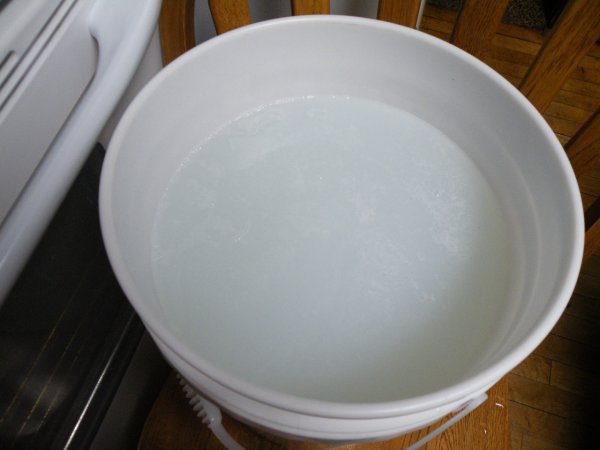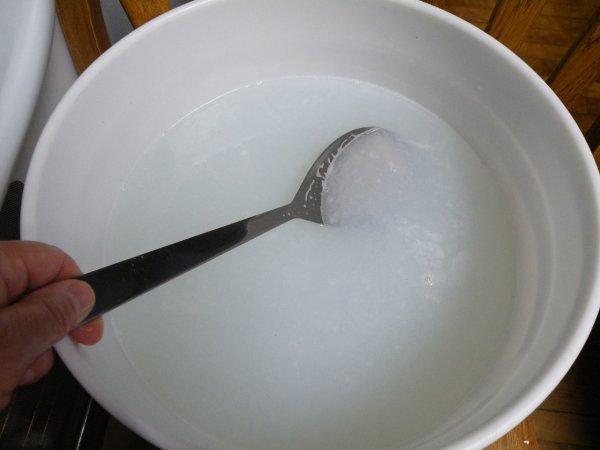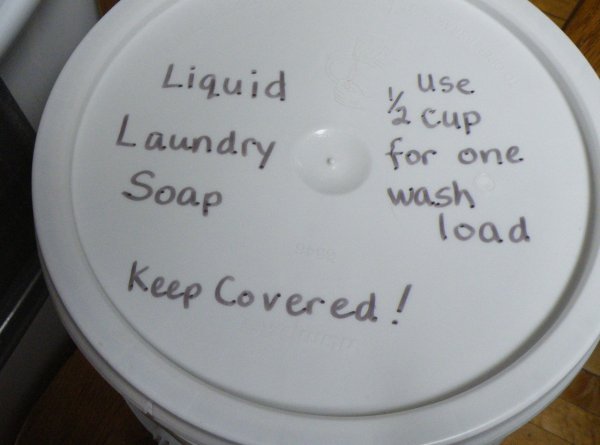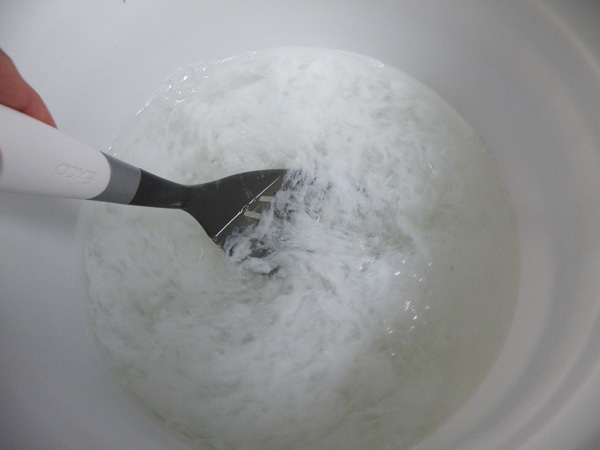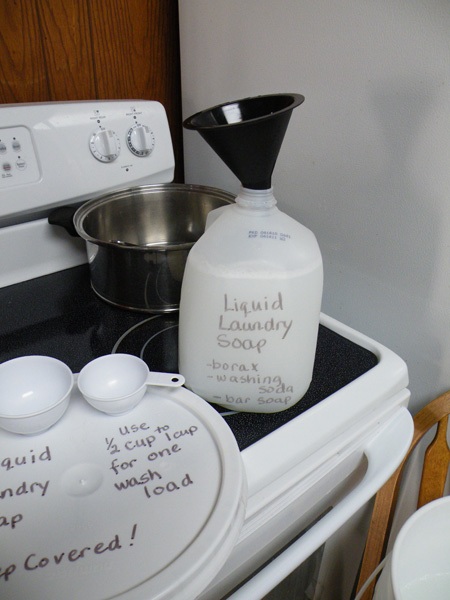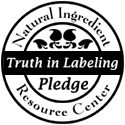The following recipe and instructions makes at least 4 gallons of cheap, low suds, safe, liquid laundry soap. Before using in a washing machine check the manufacturer’s instructions. This recipe for liquid laundry soap uses just a few natural ingredients, no synthetic colors, no fragrances or unnecessary chemicals. It is ideal for those with allergies to commercial soap products that often contain additional chemicals and synthetic fragrances.
For best results use two clear water rinses for laundry washed with this liquid laundry soap. Both the wash water and the rinse water contain only natural non-phosphorous and chemical free ingredients. They are nonpolluting and can be used as grey water for other purposes such as watering crops. Just be certain that the dirty garments washed with it did not contain toxic material in the dirt and stains that were washed out.
Since water varies from place to place in hardness and other qualities such as odor, this recipe may need adjusting to suit the water available. Ideal water to use would be clean rainwater or soft water. This recipe is then a starting point for developing a home recipe suitable to the homemaker’s situation. By changing the amounts of either the borax powder or the washing soda powder or both, the final soap mixture can be made to do what you need. Our well water often has a sulfur smell to it that sometimes clings to the freshly washed clothing. I used 1 cup of borax to 1/2 cup of washing soda in this recipe as borax is great for getting rid of odors. In the previous batch of liquid laundry soap I used 1 cup of washing soda to 1/2 cup of borax. But once in a while the sulfur odor came through to the clean clothes.
Sometimes soap scum will build up in washing machines using only hard water like that from deep home wells in limestone deposits. Soap scum is easily removed by wiping it away with a cloth dipped in plain vinegar. Or 4 to 8 fluid ounces of vinegar can be added to the second rinse every so often to prevent the build up.
For the homemaker producing an occasional 4 gallon bucket of liquid laundry soap, it is cheaper to buy the borax, washing soda and bar of soap needed, at local grocery stores than from online vendors. The excess powder not used in the recipe can be saved for future batches. Close the boxes tightly or tape them shut. If left open to the air they will absorb moisture and turn into a sold hard mass. This can happen rapidly and it then makes the powder difficult to work with. Rip open the box and whack the “brick” of powder to break it up. Just having to do this once will be enough to remember TAPE THE BOX, or pour the powder from a fresh box into a clean, dry recycled milk jug or other container that can be closed to the air.
Also borax and washing soda are natural substances which have many other uses around the house. They can also be added to very dirty loads of wash as the powders are laundry boosters. The washing soda and borax are from natural mineral deposits in the United States and go through little processing. They also occur worldwide usually in desert regions and have had many uses since ancient times. Today people in general have lost touch with these cheap, safe, simple and natural materials.
What you will need:
A clean 5 gallon plastic bucket with cover. Fleet Farm carries these in the farm equipment section. Ask at bakeries or fast food places for empty buckets they might have from things like frosting, jellies, or pickles. I bought 3 gallon size buckets for $1 each at one large grocery store but got 4 free buckets that were 5 gallon size at another large store. Ask to be on their waiting list if they are out of buckets. (These are food grade buckets so also are great for garden produce or to store large quantities of dried herbs.) Once the batch of soap is made up it can be put into smaller containers like recycled liquid detergent bottles or milk jugs.
Wash recycled bottles very well before reusing them. Label them clearly with the new contents to prevent accidental use by others not familiar with the liquid soap project.
A long handled mixing spoon or clean stick (remove bark).
Large kettle that can hold a gallon of hot water.
Measuring Cup.
Cheese grater or sharp knife to grate or chop the bar of soap.
Optional – thermometer with a long stem that will check the temp of the mixture. This is not necessary but some like to know the temperature when the bar soap pieces melt often around 140 F. Look for these where farm dairy equipment, restaurant or canning supplies are sold. A candy thermometer will work if it starts around 100 degrees F.
4 to 5 gallons of clean rainwater, or soft tap water.
Super Washing Soda Powder. This comes in a 55oz box, in the laundry soap section at large grocery stores at less than $3.00. One cupful, which weighs about 10 oz is used to make one batch of the liquid soap. The box looks like a large version of the orange Arm & Hammer box of baking soda. But in large letters on the front of the box it will say “Super Washing Soda”. If washing soda cannot be found, some have used baking soda and found it works just as well. *Avoid inhaling the powder. Washing Soda is also called Sal Soda or Soda Ash. It is sodium carbonate and is produced from natural mineral deposits in the US. Baking soda is sodium bicarbonate. They both occur naturally in the mineral called Natron, a favorite mineral of the ancient mid East, especially Egypt.
Borax Powder. Comes in a 4lb 12oz box at around $3.79. The old box is blue green color, but the new box is white. This has many uses around the house besides laundry (see the label) and is a good buy.*Avoid inhaling the powder. It is produced from natural deposits in the US. Due to increasing demand by consumers it is sometimes not available. But ask the store manager to find out when it will come in.
Bar of plain soap like Fels Naptha, Ivory, Kirk’s, Irish Spring or handmade lye soap. (Instructions are available for making handmade soap at home. The challenge is to find a reliable source of lye crystals.)
Grate or chop this bar of soap into fine pieces before beginning the recipe to save cooking time. Use at least a 3.5 or 5 oz bar. Read the labels to avoid any unwanted fragrance or other ingredients. A plain lye soap is best. See the note below at the end of this article on plain soap for more information on lye soap.
Source of heat such as a kitchen stove or hot plate, or outdoor fire
with low heat.
Time
This recipe takes about an hour to make but is very easy and can be done while doing other household or kitchen tasks.
Safety
Observe precautions and avoid having children or pets around the above powders, or near the open bucket when the soap is in it. The finished liquid soap washes easily off the skin but will leave the skin feeling very slippery. Use caution picking up anything until hands are completely dry. Flush eyes with clear water if the liquid soap is splashed into the eyes. Seek medical help if the powders are inhaled and discomfort occurs.
Instructions for Making Homemade Liquid Laundry Soap.
1.Start with 2 quarts of hot water in a large kettle. Cold water is fine it just takes longer to make the liquid soap if you start with cold water. If you can get clean rainwater, or soft water, that is best. Place this on medium heat. Do not let it come to a boil but just keep it hot. The powders and grated soap will mix better if the water is kept hot. Avoid creating bubbles, but some will occur even with slow stirring.
2.Slowly add to the hot water, while stirring it in, 1 cup (10oz by weight), Borax Powder. Avoid inhaling the powder.
3.Add 1/2 cup (4 oz by weight) Washing Soda Powder to the hot water and Borax mixture. Stir it in slowly and avoid inhaling the powder. *Note: if you happen to mix up and reverse the amounts of the powders, just keep on with the recipe. It’s really not a big deal. Just pay attention to how the laundry turns out so next time you can make the soap differently if you need to do so.
4.Stir the hot water with the Borax and Washing Soda Powders until the powders are dissolved. Just stir a bit, let it sit, come back and stir a bit more. It doesn’t need tending.
5.Add the grated, or finely chopped, bar soap and stir this into the hot water with the dissolved powders.
6.Stir this mixture slowly and avoid making bubbles. It will thicken somewhat with stringy bits of melted soap throughout. Continue to heat and stir from time to time. In about 10 minutes the grated soap will have totally dissolved and the liquid will look clear. Remove from the heat at this point. Note: If you are unable to keep the kettle on heat, or remove it from the heat too soon, the grated soap will not dissolve completely but will form a layer of soft soap on top of the liquid later on in the bucket. This is no problem, just break it up each time you stir it and get some of the soap lumps in the scoop.
7.Slowly pour the hot soap mixture into the clean 5 gallon plastic bucket.
8.Slowly add 1 gallon of warm or cold, not hot, tap water. Try not to make a lot of bubbles. Stir this slowly a few minutes until well blended.
9.Fill the bucket the rest of the way with 2 1/2 more gallons of cold water. Stir slowly and well for several minutes. This will now be a total of about 4 1/2 gallons of liquid laundry soap in the 5 gallon bucket. This is manageable for most people. The bucket can be filled to the top, but if kept at 4 1/2 gallons the extra room makes it easier to stir and dip out what is needed without splashing over the edge. Let this sit for at least one day before using so it continues to mix on its own. It will also thicken. If you need to use it right away then stir it thoroughly but slowly for at least 10 minutes.
9a. Some of the recycled plastic buckets from the bakeries were 3 gallon size instead of the 5 gallon. To make this recipe using these buckets you will need two of the 3 gallon buckets. Prepare the recipe using only one of the buckets up to the point in the previous step (9). Divide the liquid soap between the two buckets. Add 5 quarts of cold water to each of the buckets. Then proceed with the directions working with both buckets.
10.Cover the bucket. If it doesn’t close tightly put a heavy object like a stone or brick on it to prevent the mixture from drying out, being spilled, or collecting insects.
11. Label the bucket of liquid laundry soap. Keep the bucket in a cool dry place such as near the washing machine, if you use one, or in a basement, closet, or shady area outside if living outdoors. If kept for several months before it is all used up, stir once a week, especially if the soap forms a soft layer on top of the liquid. Following these directions I’ve had my liquid soap stay nice for many months until all used up. It always had a nice clean smell to it as well.
12.Keep the bucket of laundry soap away from children and pets. Little ones can drown in the bucket if they fall in.
13. Write out the liquid laundry recipe and instructions, place them into a plastic bag and attach this to the bucket for future use. Keep a non-breakable measuring cup or old soup ladle with the bucket for scooping out the liquid soap. The ladle will also work for stirring the soap.
Homemade Liquid Laundry Soap 5 days after making it. It is gelling with strings of soap forming. Stir before using.
Recycle a plastic jug to dip out a smaller amount of the liquid laundry soap for easier use. Shake gently before using.
To Use the Homemade Laundry Soap
1.A layer of thick soft soap may form on the surface of the liquid soap. This breaks up easily and will look like small soft lumps or dumplings. This is no problem. Simply stir the entire bucket briefly before dipping out what you want to use, catching a few of these lumps in the scoop. Keep a long handled spoon, or clean stick, to stir the bucket of soap before each use.
2.Once mixed briefly, scoop out 1/2 cup (4 fluid oz. or 120ml) of the liquid soap and pour into the washing machine tub. Turn on the hot water and let it mix with the soap for about a minute. Then adjust the water temperature for the type of clothes you are washing. This liquid soap is low sudsing but it cleans very well. Suds are not needed for cleaning, that is a myth.
3.After using 1/2 cup of the liquid laundry soap check the finished laundry. You might want to use less of the liquid soap or more depending upon how soiled the laundry was before washing. Usually 1/2 cup is sufficient for a full load of lightly soiled clothing. This liquid soap also makes a nice hand washing soap for delicate garments, baby clothes, presoaking cloth diapers, or just a few pieces of laundry. Keep a bottle of it near the bathroom sink. Shake it before using.
Tips:
Spots – work on heavy spots or stains on clothes before washing them. Wet the stained area and pour on some of the liquid soap from the bucket. Work the soap well into the stained area rubbing the fabric. Set aside the item for an hour and then rinse it. Repeat as needed.
For large spots, after you work the soap into the area, let it sit for an hour, then place it into a container with hot water and a 1/4 cup of the liquid soap to soak a few hours. Rinse and check. Repeat as needed. Read the instructions on the borax or washing soda box for stain removal if the liquid soap is not enough.
Heavily soiled items such as mechanics grease will need to presoak before washing. Fill the washer with hot water and the liquid soap. Add the heavily soiled clothes and start the agitation. Run for about a minute. Shut off and let sit for a few hours. Then turn on and let the cycle finish. If the heavily soiled clothes aren’t clean enough do not dry them in an electric or gas dryer. Instead either wash them again with hot water and a full cup of the liquid soap, or use 1/2 cup of the liquid soap and extra borax or washing soda powder from the box. Follow directions on the box. These are laundry boosters. Once dried in a mechanical high heat dryer the stains will be set and very hard to ever remove. So it is best to spend the extra time before the garments are dried. Some believe they will last longer also if air-dried.
For additional recipes go to http://tipnut.com/10-homemade-laundry-soap-detergent-recipes
- The Fels Naptha, Kirk’s Castile, Ivory, or Irish Spring are found in large grocery stores. Kirk’s cost about $1 a bar. Ivory can be found in bulk quantities of unlabeled bars for less than $1 a bar locally at ShopKo. These soaps can also be found at Festival Foods.
- I prefer Kirk’s soap as it is all vegetable and every ingredient is on the label. Fels Naptha is an old time favorite but the label is deceiving. Here is what it says: “Ideal for Pre-Treating Stains. Heavy Duty Laundry Bar Soap. Ingredients: Cleaners, soil & stain removers, chelating agents, colorants, perfume. Contains no naphthalene”. Fels Naptha is produced by the Dial corporation. It is common knowledge that commercial soap is made with “sodium thallowaite”. This is sodium hydroxide that is combined with beef tallow to make soap. If you do not want animal products in your laundry soap then use the Kirks’. If a soap label won’t list the true ingredients I will always suspect that the first ingredient, or main ingredient is animal fat saponified with lye. Currently soap manufacturers are not required to list all of their ingredients on the label.
- Washing Soda comes in a large 55oz box and is made by Arm and Hammer. It looks just like their smaller boxes of baking soda but it will say in large letters “Super Washing Soda”. This is sodium carbonate whereas baking soda is sodium bicarbonate. In ancient Egypt a naturally occurring salt substance called natron was used for all kinds of things from cleansing to mummifying dead bodies. Natron is sodium carbonate and sodium bicarbonate.
- Borax powder is also a natural salt found in desert areas. A popular brand “20 Mule Team” produces Borateem which is borax with additives such as perfumes and detergents. However this company also produces plain Borax and the box will state that it has no additives. It can be purchased at larger grocery stores such as the local Festival Foods. It now comes in a new box however, which is white, so it is easier to distinguish from the Borateem which has been in a blue green box. The new Borax however is not always on the shelf. The demand for it has been increasing, so at times the store’s warehouse is out of it because even the original producer can’t ship it as needed.
Note on Plain Bar Soaps
Plain bar soaps are made with animal fat or vegetable oils, or a combination of these, mixed with water, and sodium hydroxide (lye). The mixture is cooked until it begins to thicken and solidify when it is then poured into a mold, allowed to cool, and then cut into bars. It is then ready to use as finished soap. This is the “Hot Process Method” and a batch of soap from start to finish can be made in less than one day.
Or after the lye and fat/oils are mixed the raw soap is cooked for a few minutes at around 100 degrees and then poured as a raw pudding-like mixture into molds. This must be covered and left to cure for several months as it is not safe to use until all the lye has worked the fat/oils to turn it into soap. This is the most frequent method used by home artisans and is called the Cold Process Method. There are many websites with information about making soap. The best and oldest one is www.millersoap.com Either method will produce soap often for a few cents per bar.
All “soap” is made with lye or it can’t be called “soap”. The FDA has approved sodium (or potassium) hydroxide as the only chemical needed for soap making. Sodium hydroxide is used for hard bar soap while potassium hydroxide is used for liquid soap. Sodium hydroxide (lye) can be leached from wood ash by running water through a container of wood ash and then cooking that lye water with fat or oils. This is difficult to get right and have the soap turn out because, in chemistry terms, there needs to be a close balance between the fatty acids of the fat/oils and the base which is the sodium hydroxide (lye). Too much lye and the soap turns out dry, crumbly, or brittle and may burn or dry the skin. If too little lye is used the soap is greasy or remains very soft and doesn’t set up.

